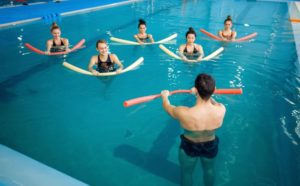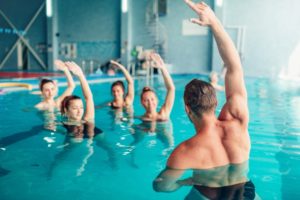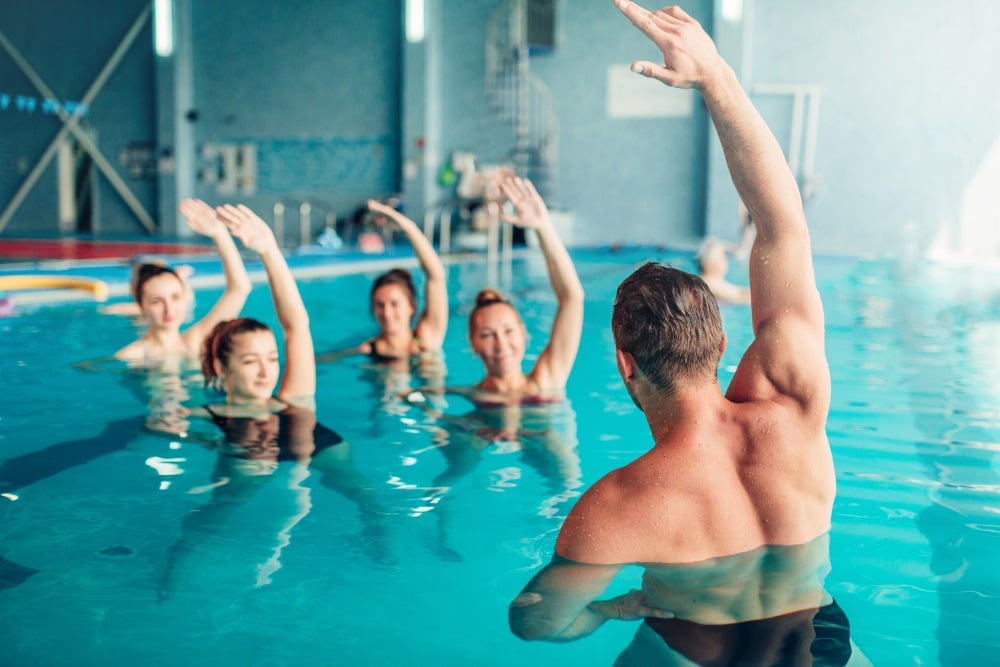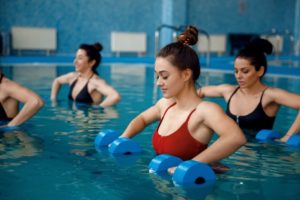Pool Exercises for Fibromyalgia Pain
If you suffer from chronic pain, more than likely your body is always tense from clenching. Clenching is caused by your body’s involuntary response to stress. When people tense up, most often not even realizing they are doing so, the flow of blood to the muscles is reduced which then causes pain. For individuals with illnesses like fibromyalgia, a stressful lifestyle combined with too much time on the couch can cause even more issues. Because insufficient activity reduces blood flow to muscles, fibromyalgia discomfort worsens. However, starting an exercise routine can help. In this article Evexia Family Chiropractic will discuss the benefits of pool exercises and go over several exercises you can do to start.
Moving Around in Water Has Its Advantages
While simply soaking in water has therapeutic benefits, exercising in water has extra advantages. Aquatic training is ideal for aerobic and strength workouts and has many benefits for people with fibromyalgia, including pain relief, increased energy, and better sleep. However, the main advantage of exercising in water is that the natural buoyancy supports joints and the body overall, eliminating the impact of land-based moves.
Pool exercises provide the advantage of a beneficial property of hydrostatic pressure, which is a compressive force exerted on the body by water. It improves circulation and reduces blood pooling and edema (swelling) in the extremities. Warm water’s thermal effects also help to increase blood flow, promote relaxation, and reduce stiffness. Also, hydrostatic pressure aids in the reduction and prevention of swelling in the extremities, while buoyancy reduces weight bearing on sore joints. Water also reduces the force of gravity on the body, allowing a person to recover from a loss of balance without injuring themselves.
Water Can Help You Feel Better
People often notice improved pain and stiffness after a session of pool exercises and the benefit of feeling better emotionally since these exercises are usually a group activity. Individuals benefit from the teacher’s support and other group members suffering similar symptoms from a social aspect. Fibromyalgia is sometimes referred to as an “invisible” disease because of few external signs of these people’s impairments. As a result, people may become socially alienated and believe that others are unaware of their symptoms.
Because of the warmth and buoyant nature of the water, most people prefer pool or aquatic exercise to land exercise. Moving painful or stiff joints and muscles in water is considerably easier than moving them against gravity on land. In addition, people are frequently unable to assume the stances or postures required to exercise certain body parts on land, but they may do so in a pool of water due to buoyancy.
However, science backs up the advantages. Many studies suggest improvement in function, pain, stiffness, and mental health following water exercise for persons with fibromyalgia, most of which include women because the ailment disproportionately impacts them.
Preparing for Pool Exercises
Always consult your physical therapist or physician before beginning any pool exercise program to ensure that aquatic workouts are suitable for you.
Below are some tips to help you get started:
- Wearing water shoes provides extra traction and stability.

- When doing pool exercises, the depth of the water should be waist-high, with a maximum depth of check-high.
- To stay afloat in deeper water, use a pool noodle or other flotation devices such as a vest or belt.
- The speed of your motions in the water will determine the amount of resistance. For example, the slower your movements are, the less resistance, while the faster your movements, the higher the resistance.
- If the goal is to add additional resistance, consider using water gloves that are webbed, weights specific for aquatic exercise, kickboards, or inflatable hoops.
- During any activity, never push your body to the point of pain.
- Staying hydrated is crucial during any type of exercise, including pool exercises.
Top Pool Exercises to Strengthen Your Body
Arm Raises
Hold both arms at your sides, using arm paddles or webbed gloves for increased resistance, and bend your elbows to 90-degrees. Next, raise and lower your elbows and arms toward the surface of the water, maintaining the 90-degree position. Perform three sets of 10 of this exercise.
Hip Kickers
Stand with the pool wall to one side of your body for support. Then, in a kicking motion, as if you are playing a kickball game, move the leg farthest from the pool wall straight forward, keeping your knee straight. Next, kick your leg to the side, similar to a vertical leg lift. And lastly, kick or thrust your leg backward. Be sure to keep your leg straight for all three motions and return to your start position after each direction. For each leg, do three sets of ten.
Lunges
Water lunges are best when done in water that is no deeper than waist-high. To do forward lunges in the pool, take an exaggerated lunge step forward, ensuring that your knee does not go past your toes, and then return to your starting position. Repeat the process with the opposite leg. Next, take an exaggerated step to the side for side lunges, ensuring that your toes are facing forward and your knee does not go past your toes. Again, repeat the process on the opposite leg alternating from side to side. For extra support on both front lunges and side lunges, hold onto the wall of the pool. Try to do three sets of ten of each exercise. If you cannot complete all three sets, that is ok; you can work up to it as you gain stamina. For increased difficulty, try walking lunges both forward and backward as well as from side to side.
One-legged Balance
Stand on one leg with the other knee raised to hip level. Place a pool noodle beneath the raised leg, forming a “U,” and position your foot, so it rests in the center. Hold the position for thirty seconds, or as long as you can, then swap legs. On each leg, do two sets of five reps. For additional support, stand with your back against the wall of the pool.
Side Steps
Face the wall of the pool and take ten to twenty sideways steps to the right. Next, take ten to twenty sideways steps to the left to return to your starting position. Repeat the process twice.
Standing Knee lift
Stand with your back against the wall of the pool wall. Both feet should be planted firmly on the pool floor at the starting position. Next, raise one knee until it is parallel to your hip, then straighten your knee. Hold the position for three seconds, then slowly bend your knee back down. Continue bending and straightening your knee for ten repetitions, then switch legs. Perform three sets of ten reps on each leg. Once you have gained more stability, perform this exercise without the aid of the pool wall.
Walking and Jogging in Water
Walking or jogging in the pool is a great exercise that helps to gain strength and endurance. Start by walking ten to twenty steps forward, then ten to twenty steps backward in water no higher than your chest. To increase the level of difficulty, increase the speed at which you are moving—alternate from walking to jogging every thirty to sixty seconds and continue for a total of five minutes.
Wall Push-ups
Facing the pool wall, place your hands, shoulder-width apart, against the edge of the wall. Your arms should be straight from the start position. Next, lean forward, placing your weight on your hands until your chest is almost touching the edge of the pool. Hold your position for three seconds before slowly pushing your body back to the starting position.
Water bicycle
Loop a pool noodle around your back and place your arms on top for support. Then, move your legs in a bicycle motion. Continue this movement for three to five minutes.
Water Planks
Hold a pool noodle directly in front of you with your arms stretched out. In a plank position, lean forward. Your elbows will be straight down towards the floor of the pool with the noodle submerged in the water. Your feet should remain on the pool floor at all times. Hold the position for fifteen to sixty sections, based on your comfort level and core muscle strength. Repeat this process for up to three to five minutes.
Last Thoughts on Pool Exercises
If you or someone you love is living with fibromyalgia, making the best use of your energy and developing a healthy routine is key. Pool exercises are an excellent way to move your body and stay active without overdoing it. Finding the right health care is important, and Evexia Family Chiropractic is dedicated to providing you with the highest quality of care possible. Lee’s Summit functional medicine and chiropractic care is just a phone call away. Schedule an appointment today!


